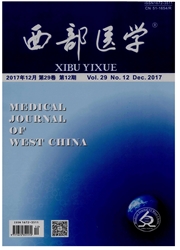

 中文摘要:
中文摘要:
目的探讨血栓素受体拮抗剂塞曲司特对COPD模型大鼠气道粘液高分泌的抑制作用及其机制。方法健康雄性清洁级SD大鼠40只,采用随机数字表法随机分为4个组,即:空白对照组、药物对照组、COPD模型组、塞曲司特药物干预组。各组动物均在第29天处死后,采集肺组织标本。石蜡包埋肺组织切片HE染色观察形态学,免疫组织化学及RT-PCR方法进行黏蛋白反基基因半定量分析,Western-Blot定量分析信号通路蛋白。结果气道粘蛋白、MUC5AC在模型组过度表达,而在对照组表达很低,使用塞曲司特干预后,其表达与COPD模型组比较,有显著降低(P〈0.01),且呈剂量依赖性(P〈0.05);COPD模型组肺组织MUC5AC mRNA及p38、P-ERK蛋白,与对照组比较,表达显著增高(P〈0.05),使用塞曲司特干预后,表达显著降低(P〈0.05),且呈剂量依赖性(P〈0.05)。结论塞曲司特可以抑制烟熏加LPS所致的气道黏液高分泌状态,其机制可能是通过抑制p38、P-ERK的表达而发挥作用。
 英文摘要:
英文摘要:
Objective To investigate the inhibition effect of seratrodast on the hypersecretion of airway mucus in rats with chronic obstructive pulmonary disease (COPD) and its molecular mechanism. Methods Forty male SD rats were randomly divided into four groups: blank control group, drug control group, model group, and drug intervention group. The expression of mucus gene (MUCSAC) and mucin in bronchial tissues was examined by histochemical analysis and alcian blue-periodic acid schiff (AB-PAS) staining, respectively. The mRNA expression of MUCSAC was measured by reverse transcription-polymerase chain reaction (RT-PCR). The signal protein p38 and P-erk expressions in lung tissue were detected by Western blot. Results The overexpression of MUCSAC, mucin, MUCSAC mRNA and signal protein p38,P-erk was seen in model group as compared with control group. The expression of MUCSAC,mucin, MUCSAC mRNA and signal protein p38,P-erk was gradually decreased in the drug intervention group (P〈0. 01 ) in a dose-dependent manner. Conclusion Seratrodast can decrease the expression of p38, P-ERK and suppress mucus hypersecretion in rat airways.
 同期刊论文项目
同期刊论文项目
 同项目期刊论文
同项目期刊论文
 Decreased expression of human aquaporin-5 correlated with mucus over production in airways of chroni
Decreased expression of human aquaporin-5 correlated with mucus over production in airways of chroni Ghrelin inhibits interleukin-8 production induced by hydrogen peroxide in A549 cells via NF-kappaB p
Ghrelin inhibits interleukin-8 production induced by hydrogen peroxide in A549 cells via NF-kappaB p Peroxisome proliferator-activated receptor γ inhibits acrolein-induced airway mucus hypersecretion i
Peroxisome proliferator-activated receptor γ inhibits acrolein-induced airway mucus hypersecretion i Increased expression of Human calcium-activated chloride channel 1 gene is correlated with mucus ove
Increased expression of Human calcium-activated chloride channel 1 gene is correlated with mucus ove Aminoguanidine attenuates bleomycin-induced pulmonary fibrosis in rats through in hibition of heat s
Aminoguanidine attenuates bleomycin-induced pulmonary fibrosis in rats through in hibition of heat s Ghrelin inhibit cell apoptosis in pancreatic beta cell line HIT-T15 via mitogen-activated protein ki
Ghrelin inhibit cell apoptosis in pancreatic beta cell line HIT-T15 via mitogen-activated protein ki 期刊信息
期刊信息
